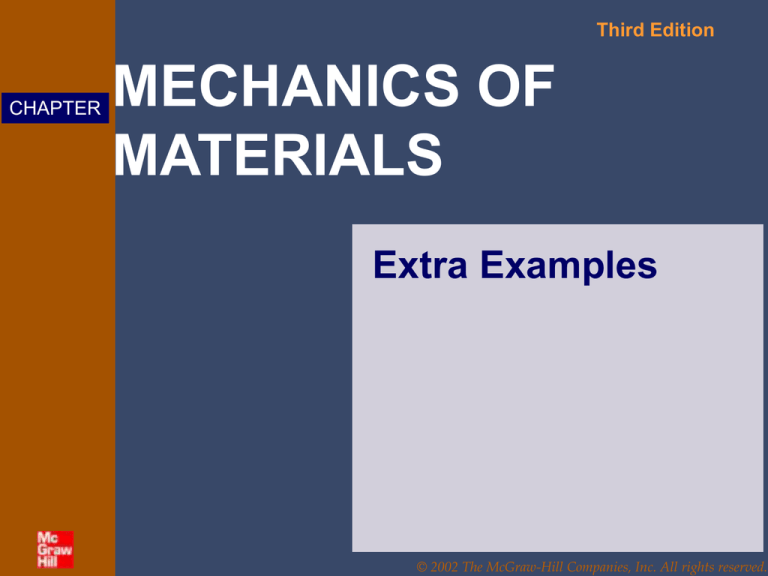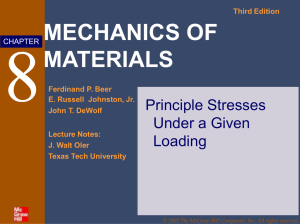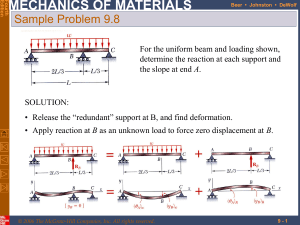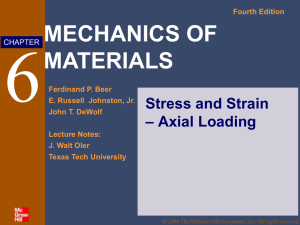
Third Edition
CHAPTER
MECHANICS OF
MATERIALS
Extra Examples
© 2002 The McGraw-Hill Companies, Inc. All rights reserved.
Third
Edition
MECHANICS OF MATERIALS
© 2002 The McGraw-Hill Companies, Inc. All rights reserved.
Beer • Johnston • DeWolf
Third
Edition
MECHANICS OF MATERIALS
© 2002 The McGraw-Hill Companies, Inc. All rights reserved.
Beer • Johnston • DeWolf
Third
Edition
MECHANICS OF MATERIALS
© 2002 The McGraw-Hill Companies, Inc. All rights reserved.
Beer • Johnston • DeWolf
Third
Edition
MECHANICS OF MATERIALS
© 2002 The McGraw-Hill Companies, Inc. All rights reserved.
Beer • Johnston • DeWolf
Third
Edition
MECHANICS OF MATERIALS
© 2002 The McGraw-Hill Companies, Inc. All rights reserved.
Beer • Johnston • DeWolf
Third
Edition
MECHANICS OF MATERIALS
© 2002 The McGraw-Hill Companies, Inc. All rights reserved.
Beer • Johnston • DeWolf
Third
Edition
MECHANICS OF MATERIALS
© 2002 The McGraw-Hill Companies, Inc. All rights reserved.
Beer • Johnston • DeWolf
Third
Edition
MECHANICS OF MATERIALS
© 2002 The McGraw-Hill Companies, Inc. All rights reserved.
Beer • Johnston • DeWolf
Third
Edition
MECHANICS OF MATERIALS
Beer • Johnston • DeWolf
At some location x, a beam can be acted upon by a
distribution load w(x), a concentrated load force P,
and a concentrated couple C
© 2002 The McGraw-Hill Companies, Inc. All rights reserved.
Third
Edition
MECHANICS OF MATERIALS
© 2002 The McGraw-Hill Companies, Inc. All rights reserved.
Beer • Johnston • DeWolf
Third
Edition
MECHANICS OF MATERIALS
© 2002 The McGraw-Hill Companies, Inc. All rights reserved.
Beer • Johnston • DeWolf
Third
Edition
MECHANICS OF MATERIALS
© 2002 The McGraw-Hill Companies, Inc. All rights reserved.
Beer • Johnston • DeWolf
Third
Edition
MECHANICS OF MATERIALS
© 2002 The McGraw-Hill Companies, Inc. All rights reserved.
Beer • Johnston • DeWolf
Third
Edition
MECHANICS OF MATERIALS
© 2002 The McGraw-Hill Companies, Inc. All rights reserved.
Beer • Johnston • DeWolf
Third
Edition
MECHANICS OF MATERIALS
© 2002 The McGraw-Hill Companies, Inc. All rights reserved.
Beer • Johnston • DeWolf
Third
Edition
MECHANICS OF MATERIALS
Beer • Johnston • DeWolf
Draw the shear and moment diagrams for the
compound beam. The three segments are connected by
pins at B and E.
© 2002 The McGraw-Hill Companies, Inc. All rights reserved.
Third
Edition
MECHANICS OF MATERIALS
The channel strut is used as a guide rail for a trolley.
If the maximum moment in the strut is M = 30 N.m
determine the bending stress at points A, B, and C.
© 2002 The McGraw-Hill Companies, Inc. All rights reserved.
Beer • Johnston • DeWolf
Third
Edition
MECHANICS OF MATERIALS
Beer • Johnston • DeWolf
The beam is made from three boards nailed together
as shown. If the moment acting on the cross section is 600
N.m determine the resultant force the bending
stress produces on the top board.
© 2002 The McGraw-Hill Companies, Inc. All rights reserved.
Third
Edition
MECHANICS OF MATERIALS
Beer • Johnston • DeWolf
The wood beam has a rectangular cross section in
the proportion shown. Determine its required dimension b
if the allowable bending stress is allow = 10 MPa.
© 2002 The McGraw-Hill Companies, Inc. All rights reserved.
Third
Edition
MECHANICS OF MATERIALS
Beer • Johnston • DeWolf
The composite beam is made of 6061-T6 aluminum
(A) and C83400 red brass (B). Determine the dimension h of
the brass strip so that the neutral axis of the beam is located
at the seam of the two metals. What maximum moment will
this beam support if the allowable bending stress for the
aluminum is (allow)al = 128 MPa and for the brass (allow)br =
35 MPa?
© 2002 The McGraw-Hill Companies, Inc. All rights reserved.
Third
Edition
MECHANICS OF MATERIALS
Beer • Johnston • DeWolf
The member has a brass core bonded to a steel
casing. If a couple moment of 8 kN.m is applied at its end,
determine the maximum bending stress in the member.
Ebr = 100 GPa, Est = 200 GPa.
© 2002 The McGraw-Hill Companies, Inc. All rights reserved.
Third
Edition
MECHANICS OF MATERIALS
Beer • Johnston • DeWolf
The concrete beam is reinforced with three 20-mm diameter steel rods. Assume
that the concrete cannot support tensile stress. If the allowable compressive stress
for concrete is (allow)con = 12.5 MPa and the allowable tensile stress for steel is
(allow)st = 220 MPa , determine the required dimension d so that both the concrete
and steel achieve their allowable stress simultaneously. This condition is said to be
‘balanced’. Also, compute the corresponding maximum allowable internal moment
M that can be applied to the beam. The moduli of elasticity for concrete and steel
are Econ = 25 GPa and Est = 200 GPa, respectively.
© 2002 The McGraw-Hill Companies, Inc. All rights reserved.
Third
Edition
MECHANICS OF MATERIALS
Beer • Johnston • DeWolf
If the T-beam is subjected to a vertical shear of 12 kip
determine the maximum shear stress in the beam. Also,
compute the shear-stress jump at the flange web junction
AB. Sketch the variation of the shear-stress intensity over
the entire cross section.
© 2002 The McGraw-Hill Companies, Inc. All rights reserved.
Third
Edition
MECHANICS OF MATERIALS
Beer • Johnston • DeWolf
If the applied shear force V = 18 kip determine the
maximum shear stress in the member.
© 2002 The McGraw-Hill Companies, Inc. All rights reserved.
Third
Edition
MECHANICS OF MATERIALS
Beer • Johnston • DeWolf
Determine the maximum shear stress in the
T-beam at point C. Show the result on a volume element
at this point.
© 2002 The McGraw-Hill Companies, Inc. All rights reserved.
Third
Edition
MECHANICS OF MATERIALS
Beer • Johnston • DeWolf
The beam is subjected to a shear force of
V = 5 kip. Determine the shear flow at points A and B.
© 2002 The McGraw-Hill Companies, Inc. All rights reserved.
Third
Edition
MECHANICS OF MATERIALS
Beer • Johnston • DeWolf
The double-web girder is constructed from two plywood sheets that are
secured to wood members at its top and bottom. The allowable bending stress
all = 8 ksi for the wood is and the allowable shear stress τall = 3 ksi is If the
fasteners are spaced s = 6 in and each fastener can support 600 lb in single
shear, determine the maximum load P that can be applied to the beam.
© 2002 The McGraw-Hill Companies, Inc. All rights reserved.
Third
Edition
MECHANICS OF MATERIALS
Determine the moment M that will produce a
maximum stress of 10 ksi on the cross section.
© 2002 The McGraw-Hill Companies, Inc. All rights reserved.
Beer • Johnston • DeWolf
Third
Edition
MECHANICS OF MATERIALS
Beer • Johnston • DeWolf
Segment A of the composite beam is made from
2014-T6 aluminum alloy and segment B is A-36 steel. If the
allowable bending stress for the aluminum 100 MPa and steel are
150 MPa and , determine the maximum allowable intensity w of
the uniform distributed load.
© 2002 The McGraw-Hill Companies, Inc. All rights reserved.
Third
Edition
MECHANICS OF MATERIALS
Beer • Johnston • DeWolf
The reinforced concrete beam is made using two steel
reinforcing rods. If the allowable tensile stress for the steel is
(allow)st = 40 ksi and the allowable compressive stress for the
concrete is (allow)conc = 3 ksi, determine the maximum moment
M that can be applied to the section. Assume the concrete cannot
support a tensile stress. Est = 29(103) ksi, Econc = 3.8(103) ksi
© 2002 The McGraw-Hill Companies, Inc. All rights reserved.
Third
Edition
MECHANICS OF MATERIALS
Beer • Johnston • DeWolf
If the beam is subjected to a shear of V = 15 kN determine the
web’s shear stress at A and B. Indicate the shear-stress components
on a volume element located at these points. Show that the neutral
axis is located at y = 0.1747 m from the bottom and INA =
0.2182110-32 m4.
© 2002 The McGraw-Hill Companies, Inc. All rights reserved.
Third
Edition
MECHANICS OF MATERIALS
Beer • Johnston • DeWolf
The beam is fabricated from two equivalent structural tees and
two plates. Each plate has a height of 6 in. and a thickness of 0.5
in. If a shear of is V = 50 kip applied to the cross section,
determine the maximum spacing of the bolts. Each bolt can resist
a shear force of 15 kip.
© 2002 The McGraw-Hill Companies, Inc. All rights reserved.
Third
Edition
MECHANICS OF MATERIALS
Beer • Johnston • DeWolf
The nails are on both sides of the beam and each
can resist a shear of 2 kN. In addition to the distributed
loading, determine the maximum load P that can be applied
to the end of the beam. The nails are spaced 100 mm apart
and the allowable shear stress for the wood is τallow = 3 MPa.
© 2002 The McGraw-Hill Companies, Inc. All rights reserved.
Third
Edition
MECHANICS OF MATERIALS
Beer • Johnston • DeWolf
The cantilevered rectangular bar is subjected to the force of 5 kip.
Determine the principal stress at points A and B.
© 2002 The McGraw-Hill Companies, Inc. All rights reserved.
Third
Edition
MECHANICS OF MATERIALS
Beer • Johnston • DeWolf
The staves or vertical members of the wooden tank are held together using
semicircular hoops having a thickness of 0.5 in. and a width of 2 in.
Determine the normal stress in hoop AB if the tank is subjected to an internal
gauge pressure of 2 psi and this loading is transmitted directly to the hoops.
Also, if 0.25-in.-diameter bolts are used to connect each hoop together,
determine the tensile stress in each bolt at A and B. Assume hoop AB supports
the pressure loading within a 12-in. length of the tank as shown.
© 2002 The McGraw-Hill Companies, Inc. All rights reserved.
Third
Edition
MECHANICS OF MATERIALS
Beer • Johnston • DeWolf
The T-beam is subjected to the distributed loading
that is applied along its centerline. Determine the principal
stress at point A and show the results on an element located
at this point.
© 2002 The McGraw-Hill Companies, Inc. All rights reserved.
Third
Edition
MECHANICS OF MATERIALS
Beer • Johnston • DeWolf
A boiler is constructed of 8-mm thick steel plates that are fastened together at
their ends using a butt joint consisting of two 8-mm cover plates and rivets
having a diameter of 10 mm and spaced 50 mm apart as shown. If the steam
pressure in the boiler is 1.35 MPa, determine (a) the circumferential stress in
the boiler’s plate apart from the seam,(b) the circumferential stress in the outer
cover plate along the rivet line a–a, and (c) the shear stress in the rivets.
© 2002 The McGraw-Hill Companies, Inc. All rights reserved.









